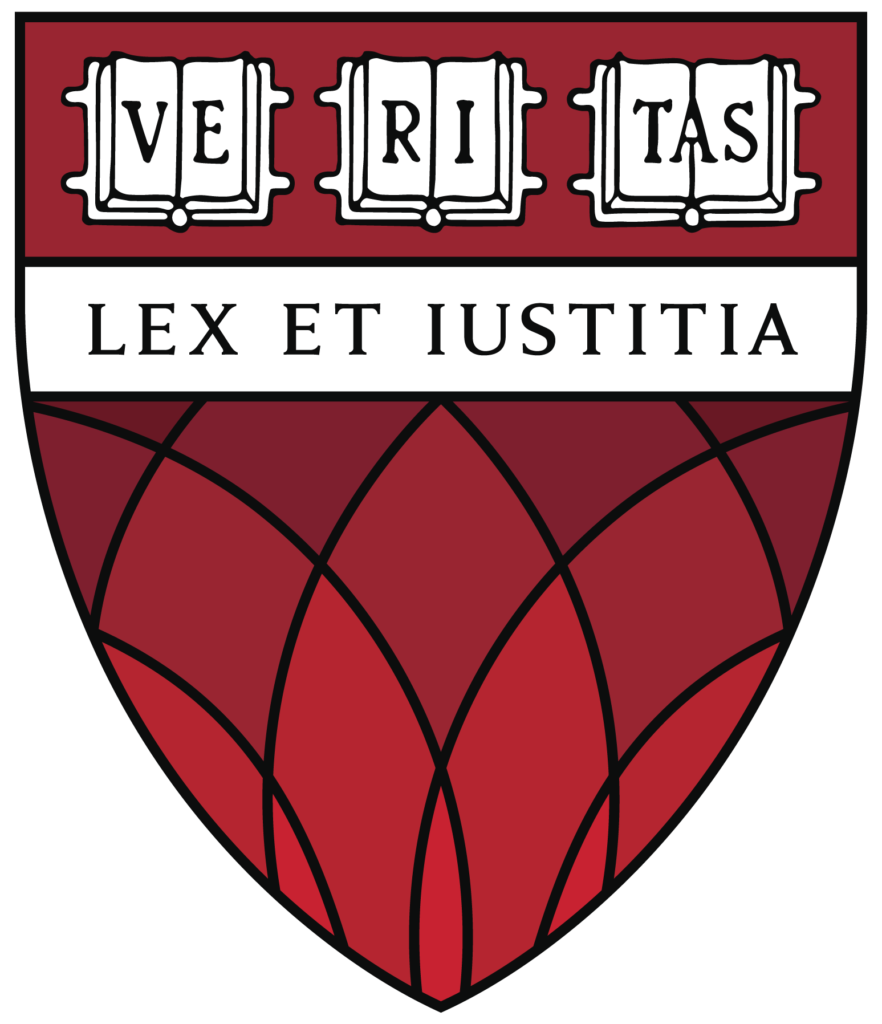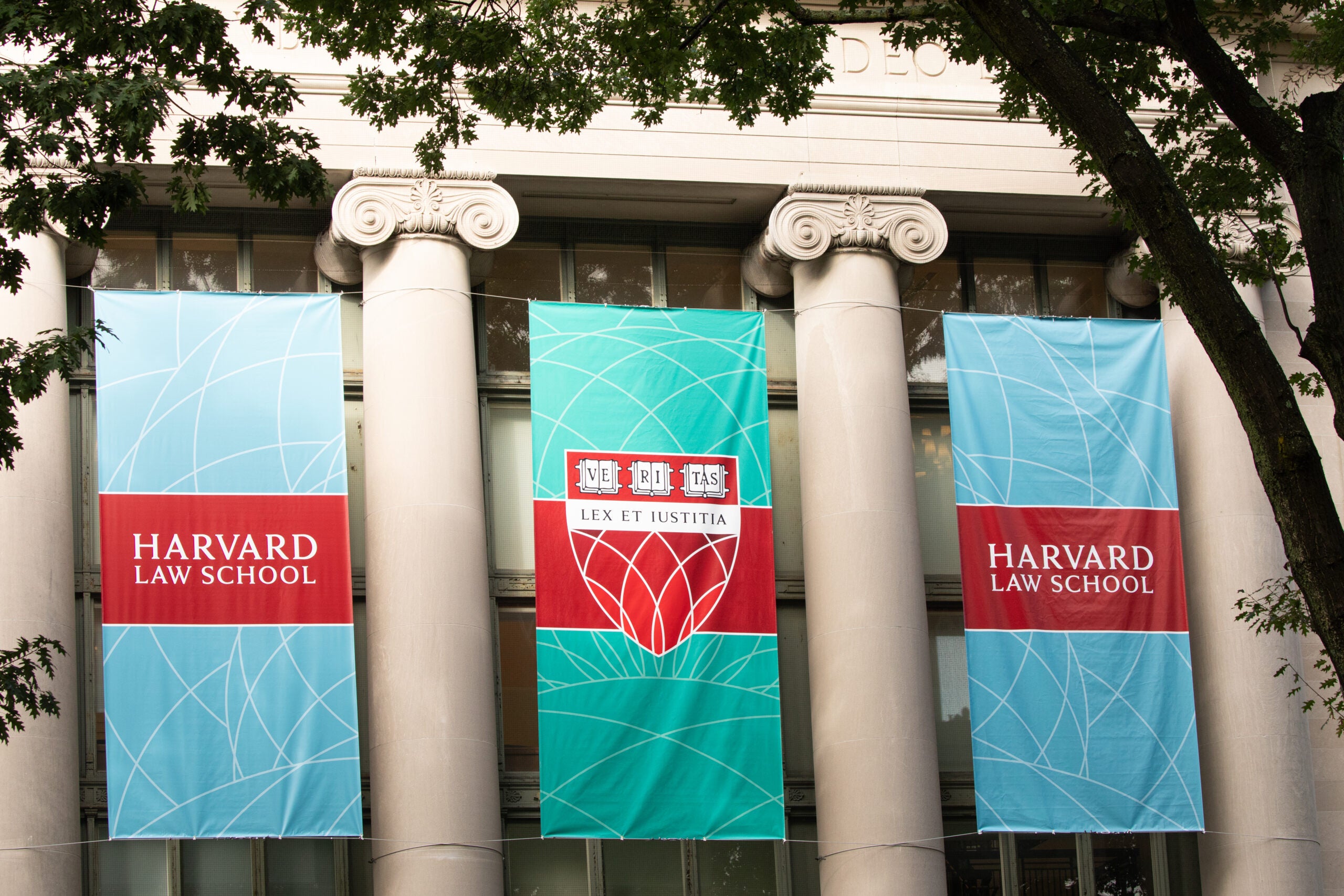Harvard Law School Dean John F. Manning ’85 today announced a new law school shield, which was researched and developed over the past year by a working group of faculty, students, alumni, and staff led by Professor Annette Gordon-Reed ’84. The new design features Harvard’s traditional motto, veritas (Latin for truth) displayed in crimson across the top, resting above the Latin phrase lex et iustitia, or law and justice. The bottom three quarters of the new shield display a series of eight overlapping, curved lines inspired by architectural details found in Austin and Hauser halls.
The new shield was the result of an extensive community outreach process and is designed to represent the broad character and values of Harvard Law School while also working well within the University’s larger suite of shields. Manning endorsed the Working Group’s recommendation and commended the shield to the Harvard Corporation, which approved the new shield last month.
“I am moved by the idea that, by combining the words lex et iustitia, with our shared motto veritas, we make explicit that Harvard Law School stands for truth, law, and justice.”
Dean John F. Manning
In an email to the HLS community, Manning, the Morgan and Helen Chu Dean and Professor of Law at Harvard Law School, wrote: “I am grateful to the members of the HLS Shield Working Group and to the members of our community for taking part in the important process of establishing a new shield for Harvard Law School. I believe that the simple, elegant, and beautiful design of this shield captures the complexity, the diversity, the limitlessness, the transformative power, the strength, and the energy that the HLS community, in Cambridge and throughout the world, sees in Harvard Law School. I am also moved by the idea that, by combining the words lex et iustitia, with our shared motto veritas, we make explicit that Harvard Law School stands for truth, law, and justice.”

In 2020, Manning convened the HLS Shield Working Group to gather input from the HLS community and work with a design team to develop and recommend a new shield. Over the past year, the working group held more than a dozen discussions with faculty, students, staff, and alumni. Opportunities for community members to engage with the working group included invitations to all students, faculty and staff to participate in focus groups, the convening of specific focus groups with the Harvard Law School Association Executive Committee and the presidents of the alumni association’s regional clubs and shared interest groups, consultation with student government leaders from two consecutive years, and the establishment of an email address to which individuals were invited to submit ideas.
The Working Group’s chair, Annette Gordon-Reed, the Carl M. Loeb University Professor, noted that the input received from faculty, students, alumni, and staff was “fascinating.”
“I have my own visions of what Harvard Law School means, what its properties are,” Gordon-Reed said. “I very much enjoyed hearing other perspectives. There were some things that kept showing up in all the groups — the focus on the size and breadth of the school, the diversity of the classes offered. HLS as a dynamic place that gives people lots of opportunities to pursue a wide variety of things came up over and over.”
The final design, she said, “represents the far-reaching nature of the school. The radiating lines suggest a projection to the outside world. We have graduates everywhere, doing all kinds of things. The HLS sphere of influence is so widely spread. Actually, I think it’s suggestive of a jewel, as well.”
Three themes came to the fore in every conversation, according to the HLS Shield Working Group’s final report. These included:
1. A Diverse and Pluralistic Community: “Harvard Law School is simultaneously grand in scope, truly excellent, and diverse along many, many dimensions. It is one of the biggest law schools in the country, with an unmatched breadth and depth. It’s been compared to a bustling city because of its physical footprint, the extensive opportunities and activities available to its students each day and every year, its student body hailing from most U.S. states and countries in the world, and its large and energetic full-time and adjunct faculty representing a broad array of disciplines and expertise. One will find at HLS an almost endless array of subjects, approaches, methodologies, ideologies, aspirations, backgrounds, and lived experiences. Many students cite this breadth and scope and diversity as a reason they came to HLS. … The school’s reach is unparalleled.”
2. Leadership that Changes the World for the Better: “Harvard Law School has produced transformative leaders from generation to generation, in field after field, in every corner of the globe. … HLS alumni have made important, game-changing contributions in private practice, public interest, government service, entrepreneurship, finance, technology, nonprofits, education, professional sports, the arts, and beyond. … Harvard Law School has also played a transformative role in legal education and legal scholarship. … Stakeholders proudly see themselves as part of HLS’s legacy of excellence, even while also appropriately asking difficult questions and challenging the conventions of the past.”
3. The Fundamental Pursuit of Law and Justice: The law is “an essential part of the fabric of civilization, embodying commitments to the rule of law, equal justice under law, due process, and democratic self-governance, among others. … Lawyers deploy facts and arguments and reason to make broad commitments to justice concrete and actionable. In other words, law provides a process for society to work out what justice entails and the means by which we give life and meaning and content to that fundamental concept. The Law School trains our students not only how to invoke the legal process in advocating for justice, but also how to criticize and seek to change the process itself.”
For Dan Eaton ’89, the former president of the Harvard Law School Association who also served on the working group, soliciting alumni feedback involved multiple focus groups, as well as reaching out through established networks, including the Harvard Law School Association Executive Committee and clubs and shared interest groups.
“[T]here was also broader outreach to the whole alumni community,” said Eaton, a partner with Seltzer Caplan McMahon Vitek, in San Diego. “Anybody was free to weigh in — and they did. Harvard Law School alums are not known for being shy about expressing their opinions.”
From Eaton’s perspective, the new shield design reflects the feedback the working group received about the excellence Harvard Law School represents, as well as the importance of justice and the rule of law. “Harvard Law School’s commitment fundamentally to the idea of law and justice was a concept that was very important to convey in the shield because, like I remember saying in my HLS yearbook, the school’s enduring preoccupation is to turn out individuals committed ‘not just to the finest practice of law but to the greatest measure of justice’. Another thing that was very central in the discussions was the idea of the importance of the rule of law as something that affects every possible area of human endeavor.”
The new shield’s design reflects these themes as well as Harvard Law School’s character generally. According to the HLS Shield Working Group’s final report, the expanding or diverging lines, some with no obvious beginning or end, are meant to convey a sense of broad scope or great distance — the limitlessness of the school’s work and mission. The radial lines also allude to the latitudinal and longitudinal lines that define the arc of the earth, conveying the global reach of the Law School’s community and impact. The multifaceted, radiating form — a form inspired by architectural details found in both Austin Hall and Hauser Hall — seeks to convey dynamism, complexity, inclusiveness, connectivity, and strength.
The traditional elements of the shield speak to the school’s history and grounding, while the more modern forms convey its ongoing evolution and aspirational nature. When combined with color, the multiple radiating lines express an internal energy, light, and strength, conveying a community with many facets and nuances. Finally, the shield makes explicit Harvard Law School’s commitment to truth, law, and justice, underscored by the Harvard veritas printed across three open books and the incorporation of lex et iustitia. As required by University guidelines, the new emblem also works well within Harvard’s broader suite of shields.
“As a law student and historian, I am so proud that the new shield presents a sense of continuity with the best of Harvard’s past, a tangible connection to the iconic spaces on campus that connects us in the present, and reflects our aspirations for the future as a community and institution.”
Catherine Katz ’23
“It was such a pleasure and an honor to be able to participate in this process of creating a new shield for Harvard Law School, which we hope will be a symbol of the law school for centuries to come,” said working group member Catherine Katz ’23. “As a law student and historian, I am so proud that the new shield presents a sense of continuity with the best of Harvard’s past, a tangible connection to the iconic spaces on campus that connects us in the present, and reflects our aspirations for the future as a community and institution. I am also so excited that we have the opportunity to share the new shield with the community now after so much time apart, as it makes the homecoming to campus feel like a celebration of what unites us.”
Working Group member Edi Ebiefung ’22 said that, while representing the perspectives of such a large and diverse community was a challenge, he believes the new shield design achieves that goal.
“As a student member of the HLS Shield Working Group, I envisioned my role as representing current students in the process of designing a new crest,” said Ebiefung. “To this end, I … help[ed] run focus groups to gather input on what HLS means to this current generation of students. As there’s a self-selection bias in these things, I tried to also gather my classmates’ thoughts on other occasions as well. The HLS community is a large one comprised of many groups. Balancing all of their expectations and interests is no simple feat. I think the new design succeeds in doing just that.”
“It’s not necessarily the flashy, dramatic emblem some might have sought, but it does have an understated elegance to it: not unlike the law itself,” Ebiefung said. “The new shield speaks to the vastness and interconnectedness of HLS and is an emblem future students will be proud of.”
The new shield replaces a previous one that reflected the family crest of Isaac Royall, Jr., who had made a bequest to Harvard College in 1779 that helped establish the first named professorship in law. The prior shield was retired in 2016 after a new history of Harvard Law School, coauthored by Visiting Professor Daniel Coquillette, shone light on the fact that Royall had earned his wealth through the labor of enslaved people. In the fall of 2015, student activists and other community members advocated for the school to discontinue use of the shield. A committee appointed by former Dean Martha Minow recommended that the shield be retired. After the Harvard Corporation approved the committee’s and Dean Minow’s recommendation, then-President Drew Faust and the governing body’s Senior Fellow, William Lee, invited the school to propose a replacement.
